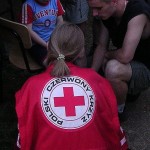Elevator Pitch for Service Online
Just as a warning: My boss decided after I had done the work that I could not use our company name, so this is a thinly veiled version of our company. Just in case you try to Google us and can’t find anything!
The Pitch:
Have you ever been in trouble and needed a social worker or a health care worker?
Have you ever wondered how they stay current? What if they are working away from the universities and continuing education providers – how do they keep up with their training then? How is that fair to clients in remote areas?
The solution is online education. At Service Online we are small, well-connected and fast. We provide just-in-time, innovative training, based on current research and best practices.
Our training is cost-effective for individuals and organizations as well as being sophisticated and engaging. We are looking for an investor to expand on our offerings to cover all of Canada, the United States and beyond.We promise part-ownership and profitability from the get-go!
Could this be you?
Contact:
Annette Smith
For more information please view our full Video Pitch :
http://www.screencast.com/t/YTliZjRh
or
http://www.viddler.com/explore/annette/videos/10/
Images not in public domain:
http://commons.wikimedia.org/wiki/File:Tastatur-deutsch-DSCN1783.jpg
November 28, 2009 11 Comments
Some comments on the history of OSS
I have been reading the comments on the dipity timeline from our presentation and wanted to address a few points. Thanks to everyone who left comments on the timeline. It would have been great to link the comments directly to the blog, but here are my responses (read: these are my thoughts, not the whole group’s).
First there were several comments that OSS does not protect the intellectual property rights of the creators. I agree that there is a real need to protect intellectual property rights with regard to software creation. However, in proprietary settings the code writers never get credit and it is the corporation or business that benefits financially from their work the most and holds all the rights. Microsoft pays it’s programmers well, but they are not doing nearly as well as Bill Gates. At least in OSS, if the software is licenced under GPL or Creative Commons, the actual programmers get to keep the IP rights to their work. If they want to develop a business around providing services to users of the product they are free to do so. If someone creates a derivative work on the shoulders of what I have done, then the IP rights to the new work should lie with them, but I would want to be credited as having made the original source.
Second, several people commented that they were surprised that ‘open-source’ style software predates PS. I truly believe that hardware and software development would have been seriously hindered if in the early days of computers there had not been a free and easy exchange of information and software between researchers and programmers. Science moves forward through the sharing of ideas, not just competition (although competition is a significant factor). One of the aims of the F/OSS community is to foster the development of new ideas and collaboration.
Lastly, I think we have to consider that OSS actually combats software piracy by giving people a viable alternative to buying shady copies of Microsoft Vista on the street corner. It also means that students can learn to use a wider aray of applications and programs than a school could provide if they had to pay high prices for software. Also students can take OSS home and extend their learning, as Eveline mentioned in one of her comments.
As we move towards things like Software as a Service, will the software we actually install on our machines continue to be something we want to pay for? Or will we be more willing to pay for services and support for software that is distributed at low cost?
October 25, 2009 2 Comments
BridgeIT Tanzania
This project, is supported by the International Youth Foundation, The Tanzania Ministry of Education and Vocational Training, Forum for African Women Educationalists, United States Agency for International Development and Nokia Siemens Networks. It distributes cell phones to teachers and gives them the capability to view information on the phones that helps them teach in elementary classrooms. The project adapts and creates mathematics, science and life skills videos and establishes the necessary technological infrastructure for teachers to access the content in their classrooms.
Face 1: Market Focus
BridgeIT is aimed at teachers in elementary schools, so the focus is k-12 (although there is an element of training involved in that the information goes to teachers to improve their instruction rather than to the children directly).
Face 2: Types of Offerings
The end product of the program is content. Information is provided to teachers on hand-held mobile phones. One of the partners of the program is Nokia, and they presumably are interested in selling mobile phones, so there may be some interest in providing hardware as well which would come under the heading of infrastructure.
Face 3: Who is the buyer?
In this case the buyer would be the schools who have agreed to be part of the project, although at this stage they are not paying for the devices or content. Perhaps, then, the buyer is the International Youth Foundation that is funding the project? Presumably the idea is to develop a product and service that can eventually be sold to schools and teachers across developing nations.
Face 4: Global Markets
This project is aimed exclusively at markets where there is poor or non -existent internet availability. If the product and the project are successful, it might be possible to market this kind of product to vast populations in Africa, Asia and the Middle East.
Face 5: Development of the Market
At the present time, this project is in a market that does not support learning technologies. The hope is that projects like BridgeIT will develop products and services that will become viable opportunities. Presumably this is why companies like Nokia are involved in the project.
Face 6: Learning Technology Competing with Other Forms of Learning
This project is bringing content into schools where there was previously no access to this kind of information. This does not compete with any other forms of learning.
October 4, 2009 1 Comment
Teen Second Life Cubed
The younger, safer, sibling of Second Life, Teen Second Life (TSL) offers educators in secondary education an opportunity to instruct in an immersive environment without putting their students at risk of harm from predators. Access to TSL is for teens and rigorously screened adults only. Movement of adults in the world is very restricted, but teens can move about freely. TSL is owned and operated by Linden Labs, the same company that owns Second Life.
Face 1: Market Focus
Teen Second Life is designed for teens 13-17 so obviously they are focused on secondary education. Because of the tight restrictions higher education institutions and corporations must go to the main Second Life grid.
Face 2: Types of Offerings
Linden Labs is offering the infrastructure in which educators and students can create content. Instructors and students can create virtual educational spaces where all the data is saved on Linden Lab’s servers, but which they can access from their own computers.
Face 3: Who is the Buyer?
There are two levels of buyer in TSL. First, they are trying to attract institutions like school to buy land and create a presence in TSL. Second, individual instructors who are early adopters of the technology may purchase land themselves. This may occur when schools are not willing to invest and the individual teacher wants to prove the concept to a principal or a superintendant. Teens can create accounts for free, so they are not buyers.
Face 4 – Global Markets
Because all the documentation and marketing for TSL is in English, the primary market would be wired Anglophone countries, with some customers coming from European countries with language skills. It would be possible for instructors from Asia and other well wired areas who had English skills to set up a virtual environment for students who would then communicate in other languages. This would mean that TSL could expand into any market that had good, high speed internet and a population with higher end computers.
Face 5 – Development of the Market
TSL targets markets with well developed internet access and a population which has access to higher end computers with good graphics capabilities. They also need to attract instructors who are willing to go outside of their classrooms and create educational experiences in a virtual world. Within that relatively narrow niche, they compete well in the market because they have all the technology and software developed for Second Life. Other educational immersive environments have less developed infrastructures, or are based on earlier versions of Second Life released as open-source projects. Linden Labs has the economically successful Second Life to drive development and improvement of both Second Life and TSL while the smaller and open source projects have fewer resources.
Face 6 – Learning Technology Competing with Other Forms of Learning
Teaching in immersive environments like TSL is currently an adjunct to teaching face to face in a classroom. The 3D building environment competes with some aspects of traditional teaching, like lab demonstrations and lectures, and provides the opportunity for students from geographically separated locations to interact and work together. In the future immersive environments may displace some aspects of traditional teaching, but with the current level of technology and the constraints of having to have a higher end computer; TSL is still very much on the fringe of teaching and learning.
September 26, 2009 3 Comments
Some links
Here are a few things I found while surfing:
The Entrepreneurial Foundation of Saskatchewan has some information on what is necessary to be investment-ready:
http://www.efsk.ca/services/investment-ready.html
This column has some good tips on pitches, including the 10/20/30 rule: 10 slides, 20 minutes including questions, 30 point font.
http://www.businessweek.com/smallbiz/content/oct2007/sb20071019_563293.htm
September 20, 2009 No Comments
Open courseware: yes, Royal Roads: no
This is my evaluation of the Royal Roads pitch. The open courseware initiative at MIT is successful, and the creation of the open courseware consortium both points towards the concept of open courseware as being successful. The pitch for RRU is asking for money without a cash return – not in itself a problem since I believe investing in education is a smart move, but for the reasons outlined below I feel this pitch is weak.
| Criteria | Royal Roads University open courseware project |
| CEO Credibility | Presenter was committed, but no indication given as to her position in the project. Style was conversational, did not give me the feeling of confidence in her ability to guide the project through development and success. |
| Management Team | Presumably the faculty at the university, but little information was given and no information was given about who would oversee the IT end of the development. |
| Business Model | The goal of the open courseware project seems to be to increase enrolment and attract faculty by using the free courseware as a marketing tool. No information was given regarding how this has worked in other universities – no statistics about MIT’s enrolment since the inception of their open courseware project. No information given about what kind of marketing will be required to get students to try the courseware – interesting since the presenter talks about how RRU is a niche university that has a history of not sharing its ideas and research with the world. |
| Competitive Products | The presenter avoided talking about the competition that MIT and 200+ other open courseware providers would create. If the concept is not new, and a large successful institution like MIT is in the picture then it would be important to cover how RRU will compete against them for students and faculty. |
| Market Readiness | From the presentation I concluded that what they are asking for is money to develop this project from the beginning. It would take several years to create the technology and then at least a few more to create the courses within it. This is a very long-term investment. If they are planning to use the technology of the open courseware consortium that would take several years off the plan, but reduce the innovation factor. |
| Technical Innovation | This plan has already been put into place at MIT. The only avenue for innovation that RRU has was hinted at when the presenter talked about being in a niche market. This was not elaborated on, so it is difficult to evaluate whether RRU would effectively solve a market problem that has not been addressed by any of the other open courseware universities. |
| Exit Strategy | Presumably, success would be an increased student body, a decorated faculty, and a well subscribed open courseware project. Unfortunately the presenter did not address this, so the EVA is left to speculate. There seems to be no way for an investor to recover their investment, so this must be a “social wealth” style proposal where the investor is being asked to be altruistic. |
| Overall Investment Status? | I like the idea of open courseware, and I think there is some possibility that it would attract paying students and faculty. I am also not opposed to investing in education for the social good it involves and the benefits to the economy of a well educated population. Unfortunately there was not enough detail about how all this would work for RRU in the presentation, which leads me to believe that there has not been enough investigation and planning to support this pitch. I would not invest in this project at this point. If there were to be a more evolved plan and pitch I would consider putting funds into it. |
September 20, 2009 4 Comments
eLearning in India
This article caught my attention, especially after listening to the Ingenia pitch. Canadian investors are looking at education in India as a potential market. At the end of the article they list some of the investments, one of which is eLearning. Maybe Ingenia should be looking at India as well…..
http://canada-indiabusiness.ca/2009/04/vcs-give-india-education-high-marks/
September 20, 2009 No Comments
Ingenia – Annette as EVA
My evaluation of the Ingenia pitch is organized in a chart, which I hope will be legible. As you will see, I was not impressed with Ramona’s pitch. Not least for her complete disregard for the difficulties involved in brining Canadian intellectual talent up to speed with regards to the language and culture of another country. This pitch focused too much on the personal experience of the presenter, and not on the capabilities of the company.
| Criteria | Ingenia – Ramona |
| CEO Credibility | Shows personal capability, but does not connect with me on a personal level, too focused on her pitch as opposed to her audience – makes me wonder if she would be able to connect with clients across cultural lines in Vietnam |
| Management Team | Other than degrees held (and not even in what field) no information about the team – especially problematic in a consulting/services firm |
| Business Model | Market exists among the multinationals for eLearning. Not sure what the role of government would be – Ramona says they will not be working with them but then mentions connections with government several times. Model is not clear. |
| Competitive Products | If the service Ingenia provides is good, then they could be competitive in this emerging market. The inability to develop a clientele at home makes me suspicious, but they do seem to have an extensive client list. Testimonials would have been helpful. |
| Market Readiness | Ingenia says they would need extensive market development time and money. There is no timetable for when projects or partnerships would start producing. There is no time given for how long it would take for Ramona’s team to become familiar with Vietnam, or if they would rely on local experts –all of which would take extensive time to get in place |
| Technical Innovation | Ingenia is not the only eLearning consultancy/service firm in the market. The edge would come from the team, but we have not been given much information on them. |
| Exit Strategy | They seem to still be in the exploratory phase of this project – hence the market development money, so I don’t think they really know what success is going to look like |
| Overall Investment Status? | There are too many unexplained or unexplored factors here for me to risk my money. The idea of tapping into an emerging market like education in Vietnam is a good one, but I would need to know more about the team and the strategy to make the company Vietnam-ready beyond paying Canadians to translate everything. |
September 19, 2009 2 Comments
Annette’s Introduction
This is my fourth MET course and I am really looking forward to it. With any luck I will be half finished the programme by Christmas. This degree has been fascinating and rewarding so far. I have been able to use so much of what I have learned in my work already.
I am a former elementary teacher who is now working for a small company putting professional development for social workers online. I am not trained as an instructional designer so it has been all about the steep learning curve!
My background is in physical anthropology and human anatomy, so I have a very diverse background and set of interests. I have never ventured into business, but I would like to in the future. I hope this course will give me the opportunity to explore this area of eLearning, and possibly prepare me better for a future in which I branch out from what I am doing now.
I am very interested in immersive worlds, like Second Life, for play and recently for education. I am looking into ways in which the “virtual” worlds can be used for teaching, learning and commerce. If you are ever in world I am Elora Habilis – drop me a line!
Looking forward to working with you all!
September 9, 2009 1 Comment




